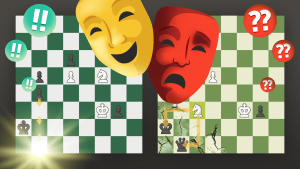I know, your first reaction to the title of today's column could be : "What?? Four Knights Game for a tactical player??" And I can understand your scepticism. Even Wikipedia says : "The Four Knights usually leads to quiet positional play", but then it adds: "though there are some sharp variations." We are going to discuss today one such sharp variation. It is especially dangerous for a player who gets lulled by the quiet start of the game. Then, when he realizes that White has a very dangerous initiative against his King it is usually too late. It all starts with symmetrical moves: 1. e4 e5 2. Nf3 Nc6 3. Nc3 Nf6 4. Bb5 Bb4 5. O-O O-O 6. d3 d6 7.Bg5 Now it is dangerous for Black to keep copying White's moves by 7...Bg4 as the next game demonstrates.
But if Black doesn't pin the Nf3 by Bg4, then White has a very dangerous plan of the attack by playing Nh4 followed by f2-f4. After the 'f' file gets open, Black King becomes really vulnerable as the next classical game shows:
In the next game Black tried to deviate by playing 9...Ng6 and bringing the Knight to defend his King. Still White manage to develop a fierce attack even in this case:
As you could see, this dangerous plan has been known for about 100 years already and yet it is still dangerous today, as the next game played by two modern players shows:
After witnessing all these massacres, you might wonder what should Black play in order to avoid such debacles. There are many ways to do it, but most of modern chess players prefer a sharp Rubinstein Variation where Black tries to seize the initiative as early as move four by playing 4...Nd4!? But this will be a subject of our next week's column!


